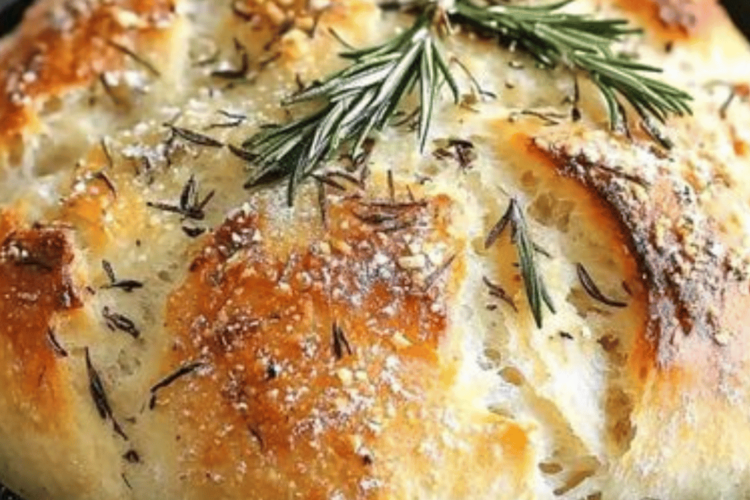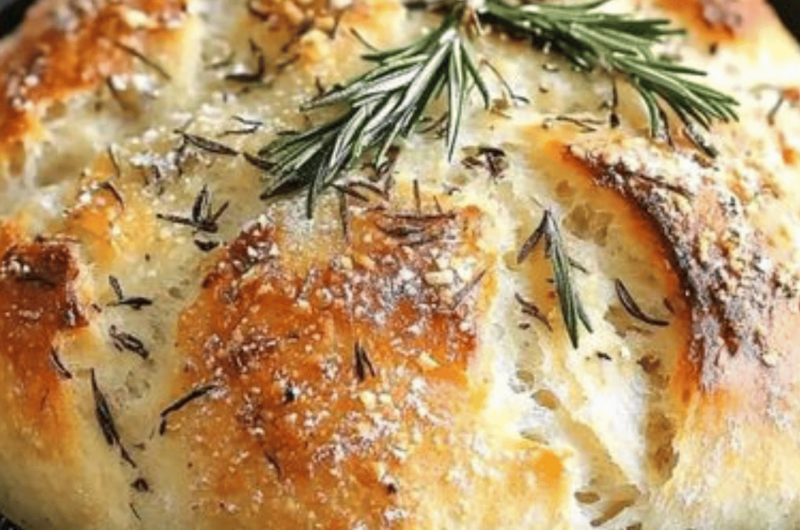Imagine the aroma of freshly baked bread filling your kitchen the earthy fragrance of rosemary, the warm notes of roasted garlic, and the golden crust of a homemade loaf. With its rustic appearance and unparalleled flavor, Rustic No-Knead Rosemary Garlic Bread is a crowd-pleaser that’s as satisfying to bake as it is to eat.
The best part? This bread is shockingly simple to make. No kneading is required, and the recipe relies on time, not effort, to create a perfectly textured loaf. Whether you’re new to bread baking or a seasoned pro, this recipe will quickly become a staple in your kitchen.
Jump to RecipeWhy You’ll Love This Recipe
- No Kneading Required: Save your arms and let time do the work.
- Incredible Flavor: Garlic and rosemary create a savory loaf that pairs beautifully with soups, stews, or a simple spread of butter.
- Perfect for Beginners: The straightforward method is foolproof, even for first-time bakers.
- Versatile Use: Serve it alongside dinner, make gourmet sandwiches, or enjoy a slice plain it’s that good.
Ingredients: Simple and Essential
This bread uses pantry staples, elevated by fresh herbs and garlic for a unique flavor twist.
Dry Ingredients:
- 3 cups all-purpose flour: The foundation of the bread.
- 3 cloves garlic, minced: Adds depth and a savory touch.
- 1 tablespoon finely chopped fresh rosemary: Or more, if you love the herby aroma.
- 1 ¼ teaspoons kosher salt: Enhances flavor.
- ¾ teaspoon freshly ground black pepper: Provides a subtle kick.
- ½ teaspoon instant yeast: Helps the bread rise without requiring kneading.
Wet Ingredients:
- 1 ½ cups water, at room temperature: Hydrates the dough, creating the sticky texture needed for a no-knead recipe.
For Baking:
- 2 tablespoons cornmeal: Prevents sticking and adds a rustic crunch to the crust.
- Olive oil or nonstick spray: Preps the skillet for an easy release.
Step-by-Step Guide
This process takes patience, but the results are well worth it. Set aside time to let the dough rise and transform into a bubbling masterpiece.
Step 1: Mix the Dough
In a large mixing bowl, combine the flour, minced garlic, chopped rosemary, salt, pepper, and instant yeast. Using a wooden spoon or clean hands, add the water and mix until a wet, sticky dough forms. This should take about 30 seconds.
Tip: The dough will look shaggy and sticky that’s exactly what you want. Resist the urge to overmix.
Step 2: Let It Rest
Cover the bowl tightly with plastic wrap to trap moisture and create the ideal environment for fermentation. Leave the dough at room temperature for 18 to 24 hours, or until the surface is dotted with bubbles.
What’s Happening? During this long rise, the yeast slowly ferments, developing a deep, complex flavor while the gluten forms naturally no kneading required.
Step 3: Prep Your Skillet
Lightly oil a 10-inch cast iron skillet or coat it with nonstick spray. Sprinkle cornmeal evenly across the surface to create a barrier between the dough and the skillet.
Why Cornmeal? It prevents sticking and adds a rustic, crunchy texture to the bottom of the loaf.
Step 4: Shape the Dough
Turn the dough out onto a lightly floured surface. Handle it gently to preserve the air bubbles. Shape it into a rough round by folding the edges under, creating tension on the surface of the dough.
Place the dough into the prepared skillet, seam side down.
Tip: Don’t overhandle the dough it’s the key to maintaining a light and airy crumb.
Step 5: Second Rise
Cover the skillet with a clean dishtowel and let the dough rest for about 2 hours at room temperature. The dough should double in size and no longer spring back when gently poked with a finger.
Step 6: Bake the Bread
Preheat your oven to 450°F (232°C). Bake the bread in the center of the oven for 30 to 40 minutes, or until the crust is golden brown and the loaf sounds hollow when tapped on the bottom.
Pro Tip: For an extra-crispy crust, place a small pan of water in the oven during baking to create steam.
Step 7: Cool and Enjoy
Allow the bread to cool in the skillet for 5 minutes, then transfer it to a wire rack to cool completely. This step is essential to let the crumb set and the flavors develop fully.
Once cool, slice into thick, rustic pieces and enjoy the earthy aroma of rosemary and garlic in every bite.
Pairing Ideas: How to Serve Rustic Bread
This bread is versatile enough to shine in various settings. Here are some ideas to elevate your dining experience:
- Soup Companion: Pair with tomato soup, minestrone, or creamy potato leek soup for a hearty meal.
- Cheese Platter: Serve alongside a selection of cheeses, olives, and cured meats for a rustic appetizer.
- Bruschetta Base: Top slices with fresh tomatoes, basil, and olive oil for a simple yet elegant snack.
- Sandwich Perfection: Use it for gourmet sandwiches with roasted vegetables, hummus, or even turkey and cranberry sauce.
Tips for Success
- Use Fresh Rosemary: While dried rosemary works in a pinch, fresh rosemary delivers the best flavor and aroma.
- Don’t Rush the Rise: The 18-24 hour rest is non-negotiable for the no-knead method to develop its unique texture and flavor.
- Handle Dough Gently: Overworking the dough will deflate the air bubbles, leading to a denser loaf.
- Invest in a Cast Iron Skillet: If you don’t have one, a Dutch oven works well for baking bread, creating a similarly rustic crust.
Variations to Try
This recipe is a fantastic base for experimentation. Consider these creative spins:
- Herb Medley: Swap rosemary for thyme, oregano, or a mix of your favorite herbs.
- Cheesy Twist: Add 1/2 cup of grated Parmesan or Gruyère to the dough for an indulgent loaf.
- Olive Addition: Fold in chopped Kalamata olives for a Mediterranean-inspired bread.
- Whole Wheat Swap: Replace 1 cup of all-purpose flour with whole wheat flour for a nuttier flavor.
Storing and Freezing
This bread is best enjoyed fresh but can be stored for later use.
- Room Temperature: Store in a bread bag or airtight container for up to 2 days. Reheat in the oven to revive the crust.
- Freezer: Wrap the loaf tightly in plastic wrap and foil before freezing. Thaw at room temperature and reheat for a freshly baked taste.
Nutritional Information
| Serving Size | 1 slice (based on 8 servings) |
|---|---|
| Calories | ~150 kcal |
| Carbs | ~30g |
| Protein | ~4g |
| Fat | ~2g |
Why No-Knead Bread Works
The science behind this recipe is simple yet fascinating. The long resting time allows gluten to develop naturally while fermentation enhances the flavor. This eliminates the need for kneading while achieving a bakery-quality loaf.
A Bread That Feels Like Home
There’s something deeply satisfying about creating your own loaf of bread. Rustic No-Knead Rosemary Garlic Bread isn’t just a recipe it’s an experience. The process of mixing, waiting, and baking connects you to the tradition of breadmaking, and the result is a loaf full of love and flavor.
So, roll up your sleeves, grab your mixing bowl, and let this recipe transport you to a rustic bakehouse, where the simple pleasures of fresh, homemade bread reign supreme. Happy baking!
Rustic No Knead Rosemary Garlic Bread
8
servingsThis flavorful bread is packed with garlic and rosemary. The perfect combination of flavors and textures will leave you craving more. Enjoy this special occasion treat for a satisfying side dish.
Ingredients
3 cups all-purpose flour
3 cloves garlic, minced
1 tablespoon finely chopped fresh rosemary, or more, to taste
1 ¼ teaspoons kosher salt
¾ teaspoon freshly ground black pepper
½ teaspoon instant yeast
1 ½ cups water, at room temperature
2 tablespoons cornmeal
Directions
- In a large bowl, combine flour, garlic, rosemary, salt, pepper, and yeast.
- Using a wooden spoon or your hand, add water and mix until a wet, sticky dough forms, about 30 seconds.
- Cover the bowl tightly with plastic wrap and let stand at room temperature until the surface is dotted with bubbles, about 18 to 24 hours.
- Lightly oil a 10-inch cast iron skillet or coat with nonstick spray; sprinkle with cornmeal.
- Working on a lightly floured surface, gently shape the dough into a round.
- Place the dough into the prepared skillet.
- Cover with a clean dishtowel and let stand at room temperature until the dough has doubled in size and does not readily spring back when poked with a finger, about 2 hours.
- Preheat oven to 450 degrees F. Place into oven and bake until golden brown, about 30-40 minutes.

